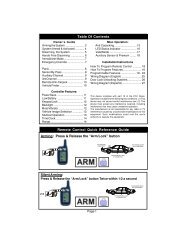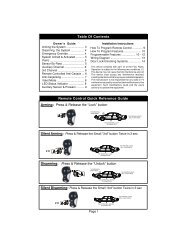You also want an ePaper? Increase the reach of your titles
YUMPU automatically turns print PDFs into web optimized ePapers that Google loves.
K9<br />
CLASSIC-<br />
BACK COVER<br />
PRINTER’S NOTE:<br />
production back cover<br />
is to be printed with gray<br />
scale front cover; this is a<br />
place marker cover.<br />
EDP2<br />
INSTALLATION<br />
INSTRUCTIONS<br />
FRONT COVER<br />
PRINTER’S NOTE:<br />
production front cover<br />
is gray scale; this is a<br />
place marker cover.<br />
Jan 2009 MI-K9-CLASSIC-EDP2<br />
COPYRIGHT 2010: OMEGA RESEARCH & DEVELOPMENT, INC.
Contents<br />
Wiring Diagram Overview ........................................................................... 18-19<br />
Installation Considerations ........................................................................... 3-5<br />
Status Light & Valet Switch<br />
Wiring Connections<br />
Main Wiring Harness ................................................................................... 6-8<br />
Secondary Wiring Harness ........................................................................... 9-15<br />
Accessory Connections<br />
DLS Power Doorlock Port...............................................................16-17 & 20-21<br />
Backup Battery Port ..................................................................................... 21<br />
Sensor Port ................................................................................................... 21-22<br />
Data Port ....................................................................................................... 22<br />
(-) Light Flash/Horn Honk, Options Port ..................................................... 22<br />
Mounting the Transceiver or Coaxial Antenna ............................................ 22<br />
Programming<br />
The Programmable Features ......................................................................... 23-31<br />
Programming Features .................................................................................. 32<br />
Programmable Features Matrix .................................................................... 33<br />
The K9-CLASSIC-EDP2’s transmitters are pre-programmed at the factory to<br />
operate the system. If adding or replacing transmitters or controllers, please<br />
see the Operation Guide booklet for Transmitter and Controller<br />
programming.<br />
Omega Disclaims Any Responsibility or Liability In Connection With Installation.<br />
Copyright 2010 Omega Research and Development, Inc.<br />
Page - 35
Universal Relay Diagram<br />
Pin 86 and Pin 85 are the relay’s Coil pins.<br />
(+) Positive and (-) Negative 12 volts on these pins<br />
activate the relay. It is a good installation<br />
practice to consider<br />
Pin 86 as (+) and<br />
Pin 85 as (-).<br />
30<br />
86 87a 85<br />
Pin 30 is INPUT,<br />
also known<br />
as Common.<br />
“footprint” view, 87 as looking at relay<br />
Pin 87 is OUTPUT when<br />
the relay IS activated, also<br />
known as Normally Open.<br />
Pin 87a is OUTPUT<br />
when the relay is NOT<br />
actived, also known<br />
as Normally Closed.<br />
- IMPORTANT -<br />
The K9-CLASSIC-EDP2 is a 1-way security<br />
system. This installation booklet describes this<br />
model; please <strong>car</strong>efully read these instructions<br />
before starting the installation. The numerous<br />
wiring connections required, and the options<br />
offered by several of the programmable features<br />
makes pre-planning the installation critical.<br />
More complete instructions for programming<br />
transmitters and features may be found in the<br />
Operation Guide manual.<br />
Installation Considerations<br />
Before Starting The Installation: This entire booklet should be read<br />
before starting the installation. An understanding of which control module wires<br />
are to be used and their functions is essential. Installations will vary from <strong>car</strong> to <strong>car</strong><br />
, as some control module wire connections are required, while others are optional.<br />
Before starting the installation, it should be determined which control module<br />
wires will be used. Most installers will list these wires, then "map out" the installation<br />
by locating and noting the target wires in the vehicle. This will also determine<br />
the best location for the control module, which is mounted upon completion<br />
of the installation and testing of the system.<br />
Some of the wiring connections, such as power, ignition and starter interrupt, are<br />
best made at the ignition switch harness, located around the steering column area.<br />
CAUTION! Avoid the Airbag circuit! Especially avoid any harness<br />
or wires encased in Yellow or Red tubing or sleeves. Do not use<br />
a standard test light, as it can deploy an airbag or damage onboard<br />
computers and sensors if the wrong circuits are probed. A<br />
Digital Multimeter (DMM) should be used.<br />
Page - 34<br />
Other typical connection points may be behind the dash or in the kick panel areas,<br />
for parking and/or interior lights, trigger circuits and power doorlocks. Soldering<br />
or proper use of crimping terminals for all wiring connections are recommended.<br />
Page - 3
Mounting The Control Module: The Control Module contains the<br />
necessary electronics required for the system's operation. Always mount this module<br />
in the vehicle's interior compartment, in a secure location that is not easily<br />
accessible. Ensure that moisture, vibration and temperature extremes are minimized.<br />
Acceptable locations include mounting behind the dash, behind the glovebox<br />
or other interior panels.<br />
Mounting The Electronic Siren: The electronic “2-n-1 Psycho Siren”<br />
must be mounted external to the vehicle but not accessible or vulnerable to tampering.<br />
Locations in the engine compartment typically offer the best mounting<br />
opportunities. See page 9 for specific mounting and connection details.<br />
:<br />
The Status Light and Valet Switch: For the Status Light drill a 9 / 32”<br />
hole in a suitable interior panel; be sure to <strong>car</strong>efully ensure that the area behind<br />
the location has an unobstructed depth of at least 1/2”. Then route the wiring<br />
harness through the hole to the control module, and snap the light in place.<br />
Mount the Valet Switch, using its adhesive pad, in a hidden location which is<br />
accessible to the operator; <strong>car</strong>efully route the wires to the control module.<br />
Or, use the combination holder for the Status Light and Valet Switch.<br />
Mountcan be mounted independently or mounted in an included combination<br />
holder.<br />
The K9-CLASSIC-EDP2 may be upgraded to 2-way operation, which adds the<br />
transceiver to the system.<br />
Complete Programmable Features Matrix<br />
Features Ignition on, off, then press Valet Switch 5 times (Status Light turns on steady).<br />
# Feature Default Setting Option 2nd Option 3rd Option<br />
1 SecureCode 1 & 0 2 stages, of up to 9 presses each (total of 99 possible combinations)<br />
2 Last Door Arming OFF (L) ON w/o doorlock (U) ON w/ doorlock (2)<br />
3 Automatic Rearming OFF (L) ON w/o doorlock (U) ON w/ doorlock (2)<br />
4 Starter Interrupt Functions Alarm only (L) Off (U) Automatic (2)<br />
5 Ignition Activated Override OFF (U) ON (L)<br />
6 Doors Lock With Ignition On ON (L) OFF (U)<br />
7 Doors Unlock With Ignition Off ON (3) OFF (L) o/p 1 only (U) o/p 2 only (2)<br />
8 Open Door Bypass to above ON (L) OFF (U)<br />
9 Confirmation Chirps ON (L) OFF (U) exc. Valet (2) Valet only (3)<br />
10 Confirmation Chirp Volume Medium Loud (2) Low (L) Med Lo (U) Loud (3)<br />
11 Activated Alarm Cycle 30 Seconds (L) 60 Sec. (U) 90 Sec. (2) 120 Sec. (3)<br />
12 Lights On Upon Disarm ON (L) OFF (U)<br />
13 Disarm Upon Trunk Release ON (L) OFF (U)<br />
14 Arming Delay 3 Seconds (L) 15 Seconds (U) 30 Seconds (2) 45 Seconds (3)<br />
15 Steady Siren / Pulsed Horn Steady Siren (L) Pulsed Horn Lo (U) Pulsed Med. (2) Pulsed Hi (3)<br />
16 Alarm Functions Bypass OFF (U) ON (L)<br />
17 Ignition Anti-Carjacking OFF (U) ON (L)<br />
18 Door Anti-Carjacking OFF (U) ON (L)<br />
19 Remote Anti-Carjacking OFF (U) ON (L)<br />
20 Open Door Warning at Arm OFF (U) ON (L)<br />
21 III Button Operation 3rd Chan. (L) Panic (U) 4th Chan. (2) 5th Chan. (3)<br />
22 Doorlock Functions .8 second (L) 3 Seconds (U) Double Unlock (2) Total Closure (3)<br />
23 (-) Parking Light Output Parking Light (U) Arm (L) Chan. 4 Latch (2) Chan. 4 On Demand (3)<br />
24 (-) Horn Output Horn, med (U) Disarm (L) Chan. 5 Latch (2) Chan. 5 On Demand (3)<br />
Page - 4<br />
Page - 33
Enter Programming mode:<br />
Step 1<br />
Step 2<br />
Step 3<br />
Change the Feature:<br />
Step 5<br />
Step 6<br />
Turn the ignition off.<br />
Programming Features<br />
Turn the vehicles’s ignition on.<br />
Within 5 seconds, Press & Release the Valet Switch 5 times.<br />
• The siren will chirp then sound briefly and the Status Light will light<br />
steady to confirm that the system is entering Programing Mode.<br />
Access a Feature:<br />
Step 4 Within 10 seconds, Press & Release the Valet Switch the same<br />
number of times as the desired feature’s number.<br />
• The siren will chirp and the Status Indicator Light will flash off the same<br />
number of times as the Valet Switch was pressed to indicate the feature<br />
number accessed.<br />
After accessing the desired feature, within 10 seconds Press &<br />
Release the appropriate controller or transmitter button.<br />
• Pressing the “arm/lock” button typically turns the feature on; or sets the<br />
feature’s first option. The siren will chirp once when this button is pressed.<br />
• Pressing the “disarm/unlock” button also typically turns the feature off;<br />
or, sets the feature’s second option. The siren will chirp twice.<br />
• Many features have third, and even fourth setting options. Pressing the<br />
“II” and “III” buttons select these options. Confirmation chirps when<br />
these buttons are pressed are three and four chirps respectively.<br />
To Access and Change further Features:<br />
If there are more features to be programmed, within 10 seconds of<br />
the previous action Press & Release the Valet Switch the same<br />
number of times as the next desired feature’s number.<br />
• Again the siren will chirp and the Status Indicator Light will flash as many<br />
times as the Valet Switch was pressed to indicate the new feature number<br />
which is now accessed. Then use the controller or transmitter as described<br />
in Step 5 to change the newly accessed feature as desired.<br />
Exit Programming mode:<br />
Step 7 Allow 10 seconds to pass without performing any programming<br />
actions, or turn the vehicle’s ignition on.<br />
• The siren will sound briefly and the Status Indicator Light will go out.<br />
Page - 32<br />
the assembly in a location where it can easily be seen by the driver, and preferably<br />
where it can be seen from outside. Two mounting methods are provided: doublesided<br />
adhesive tape, and two screws. If using the adhesive tape, properly prepare<br />
the mounting surfaces to ensure good adhesion. If using the screws for a more<br />
permanent mounting, <strong>car</strong>efully separate the housing halves, install the screws<br />
(avoid overtightening), then snap the assembly halves back together. Carefully<br />
route the wiring harness to the control module to avoid any chances of it being<br />
chafed or pinched.<br />
Power Doorlock Options: The K9-CLASSIC-EDP2 has the flexibility<br />
of these options for interfacing the vehicle power doorlocks.<br />
DLS Port- This option is the traditional “DLS” port, which can direct-wire<br />
basic 3-wire Negative pulse doorlocking systems, and accept all Omega analog<br />
doorlocking accessories (dual, triple relay sockets, or the modular clip-on add-on<br />
relay packs). All Omega doorlocking data bus module accessories can be driven by<br />
this port. The DLS port offers two unlocking outputs, so that driver’s door priority<br />
unlocking can be configured. See pages 16-21 for basic wiring diagrams.<br />
Data Port for IntelliKit & OmegaLink Modules & Bypasses: Omega<br />
IntelliKit & OmegaLink data bus interface modules and bypass kits simply plug into<br />
this port. These data-to-data (D2D) accessory products save time, and in many<br />
cases offer the only acceptable interface means for many newer vehicle’s doorlocking<br />
system and/or for the OEM-antitheft bypass when adding an <strong>alarm</strong> or an optional<br />
accessory remote start module with the K9. Omega offers the industries most<br />
comprehensive line of these products (go to www.<strong>car</strong><strong>alarm</strong>.com for latest application<br />
guide), and each includes its own vehicle-specific instructions. Also see page 22.<br />
Backup Battery: Both models have backup battery capability. If the system<br />
loses vehicle power it will revert to operating with basic security functions, if the<br />
backup battery is installed. See page 21 for installation details.<br />
Auxiliary Sensor Port: The K9 includes an impact sensor which<br />
conveniently plugs directly into an auxiliary sensor port. All Omega sensors are fully<br />
compatible with the K9’s sensor port. An available Sensor Expansion Module (AU-<br />
EXP) allows plug-in usage of multiple sensors. See page 21.<br />
Programmable Outputs: Both models also have two additional Negative<br />
outputs which are programmable. As received they are dedicated “negative parking<br />
light” and “horn honk” outputs, but if desired these can be used for a OEM <strong>alarm</strong><br />
arm, OEM <strong>alarm</strong> disarm or 4th and 5th remote channel outputs.<br />
See page 22 for instructions regarding the unit’s Coaxial Antenna Cable.<br />
Page - 5
Wiring Connections<br />
- NOTE -<br />
The following sections detail connections for each wire, of<br />
each system’s wiring harnesses. Always insure that the<br />
Black ground wire is grounded, and that the secondary<br />
wiring harness is plugged in, before connecting power<br />
circuits to the control module. The best installation procedure<br />
is to make all connections, and only then plug the<br />
individual wiring harnesses into the system control module.<br />
Main Wiring Harness<br />
(5-Wire Connector)<br />
Black Wire - (Ground): The Black wire provides Negative ground for the<br />
system; proper connection of this wire is very important.<br />
CONNECTION: Using the correctly sized crimp-on ring terminal, connect the<br />
Black wire to the metal frame of the vehicle, preferably using an existing machinethreaded<br />
fastener. Make sure that the ring terminal attached to the Black wire has<br />
contact with bright, clean metal. If necessary, scrape any paint, rust or grease away<br />
from the connection point until the metal is bright and clean. If the control module<br />
has an insufficient ground connection, the security system can find partial ground<br />
through the wires that are connected to other circuits, and function, but not<br />
correctly. As the system can partially operate, a bad ground wire connection would<br />
not likely be suspected, and in many cases a poor ground is difficult to diagnose.<br />
Red Wire - (Constant Power Input): The Red wire's function is to<br />
supply Constant Positive 12 Volts for security system's operation. When 12 Volts<br />
is first applied to the Red wire, the system will revert to the state in which it was in<br />
when power was taken away. If the vehicle is to be serviced, especially if it involves<br />
the battery, the system should be placed in Valet Mode. This will prevent the system<br />
from being activated if the battery is disconnected and reconnected. The Red wire<br />
also supplies 12 Volt Positive to the module's internal relay for flashing the parking<br />
lights.<br />
CONNECTION: Connect the Red wire to a Constant Positive 12 Volt source.<br />
This source should have Positive 12 Volts with at least a 15 Amp capacity at all times<br />
and in all ignition key positions. Connection locations can be at the supply wire at<br />
Page - 6<br />
pressing the “arm/lock” or “disarm/unlock” button. Only the output itself<br />
will stop- pressing either button again will normally operate the system, and at<br />
any time after the 28 second lock output period ends.<br />
If either of the programmable outputs are set for lock or unlock operation (the next<br />
two Programmable Features), the settings if this feature will operate the programmable<br />
outputs accordingly, in addition to the system’s primary DLS port doorlocking<br />
outputs.<br />
Feature #23 (-) Parking Light Output Functions<br />
Factory Default Setting Parking Light Flash Output<br />
(press “disarm/unlock” button to program)<br />
Options:<br />
OEM Alarm Arm Output (press “arm/lock” button to program)<br />
Channel 4 Latch Output (press “II” button to program)<br />
Channel 4 On Demand Output (press “III” button to program)<br />
The default setting of this feature is to provide a negative flashing light output.<br />
Options for this output are a (-) OEM <strong>alarm</strong> arm output, which is more frequently<br />
encountered in newer vehicles. Other options are an additional remote output,<br />
operated by the transmitter’s “arm/lock” and “II” buttons together, and in two forms<br />
of operation: “Latch”, in which the output toggles (i.e.- turns on and turns off) with<br />
each buttons press, and “On Demand” which is output occurring while the buttons<br />
are being pressed. Feature #21 can change this channel’s button assignment.<br />
Feature #24 Horn Honk Output Functions<br />
Factory Default Setting Horn Honk Output<br />
(press “disarm/unlock” button to program)<br />
Options:<br />
OEM Alarm Disarm Output (press “arm/lock” button to program)<br />
Channel 5 Latch Output (press “II” button to program)<br />
Channel 5 On Demand Output (press “III” button to program)<br />
The default setting of this feature is to operate the vehicle’s existing horn; either in<br />
conjunction with the electronic siren, or in place of the siren. Using both the siren<br />
and the horn creates an extremely effective security system, and be configured in<br />
many vehicles without further parts. The remaining options are OEM <strong>alarm</strong> disarm,<br />
and Channel 5, with the same operation parameters as described above for Channel<br />
4, except that the “disarm/unlock” and “III” buttons operate it, and Feature #21 can<br />
also change this channel’s button assignment.<br />
CAUTION! Do not exceed the output capacities of either wireboth<br />
outputs are rated at (-) Negative 250mA.<br />
Page - 31
Options:<br />
Panic<br />
(press “disarm/unlock” button to program)<br />
4th Channel<br />
(press “II” button to program)<br />
5th Channel<br />
(press “III” button to program)<br />
This feature changes how the controller’s or transmitter’s “III” button operates.<br />
Normal operation, or the default setting, has the “III” button operate the 3rd Channel<br />
output (press the button twice within 5 seconds). This feature allows changing it to<br />
instead operate panic or either of the two other optional channel outputs (see the<br />
Complete Programmable Features Matrix on page 33). Panic can always be<br />
operated, by the alternative methods of pressing either the “arm/lock” and “disarm/<br />
unlock” button for 3 seconds.<br />
Feature #22 Doorlocking Functions<br />
Factory Default Setting .8 Second Lock & Unlock Output<br />
(press “arm/lock” button to program)<br />
Options:<br />
3 Second Lock & Unlock Output (press “disarm/unlock” button to program)<br />
Double Pulse Unlock Output (press “II” button to program)<br />
Total Closure Lock Output<br />
(press “III” button to program)<br />
This single feature gives the installer several needed options, to match the security<br />
system’s doorlocking outputs to suite different vehicle requirements.<br />
• The first setting (programmed by the “arm/lock” button) has the system<br />
produce both the lock and unlock outputs as .8 second in duration. This is the<br />
most common form of output needed, which interfaces most vehicles.<br />
• The second setting (programmed by the “disarm/unlock” button) changes the<br />
lock and unlock outputs to be a longer 3 second pulse output. This is for certain<br />
vehicles which require a longer output pulse from the system’s control unit;<br />
typically <strong>car</strong>s having vacuum pump systems, although the longer setting is also<br />
more suitable in some newer vehicles.<br />
• Some newer vehicles require a double pulse output to remotely unlock the doors<br />
and/or to disarm a factory-equipped security system, which is what the Double<br />
Pulse Unlock setting provides (it is programmed by the “II” button ). The lock<br />
output pulse, in this setting, is .8 second.<br />
• The Total Closure Lock Output (programmed by the “III” button) may be used<br />
with vehicles which are originally equipped with the total-closure feature.<br />
Typically, a total closure feature is when locking the vehicle’s doors if the key<br />
in the door is held to “lock” for a period of time the vehicle will close all<br />
windows and the sunroof, in addition to locking the doors.<br />
Selecting this feature setting changes the system’s door lock output pulse from<br />
a .8 second to as long as a 28 second duration output. The unlock output is 3<br />
seconds in this setting.<br />
Note: When this feature is turned on, during the 28 second period after arming<br />
the system, the lock output can be stopped on demand by the user by<br />
Page - 30<br />
the ignition switch, the supply wire behind the fuse block or the fuse/junction block.<br />
Never just insert the Red wire or any other security system wire behind a fuse. Also,<br />
please note that connecting directly to the battery's Positive terminal will expose this<br />
connection to failure due to a corrosive environment unless the connection has a<br />
protective coating.<br />
Yellow Wire - (Ignition Input): The Yellow wire is an ignition "on"<br />
input to the security system. This connection is critical to the proper operation of<br />
many of the security system's features.<br />
CONNECTION: This wire supplies Positive 12 Volts to the control module<br />
whenever the ignition switch is "on". This connection should be made at the ignition<br />
switch harness, to the primary ignition circuit. Primary ignition has 0 Volts when<br />
the ignition key is in the "Lock", "Off" and "Accessory" positions; and Positive 12<br />
Volts in the "Run" and "Start" positions. Locate the correct wire at the ignition<br />
switch harness and securely splice the Yellow wire to it.<br />
Orange Wire - (Negative Output While Armed); Includes the<br />
thick Red & White Wires attached to the relay socket - (Starter<br />
Interrupt): The Orange wire is a starter interrupt output, which is active when<br />
the security system is in an armed state; the relay that it is attached to the Orange wire<br />
prevents the starter from engaging, if a starting attempt is made while the system is<br />
armed.<br />
CONNECTION: The typical starter interrupt is shown here-<br />
Dashmounted<br />
Ignition<br />
Switch<br />
Starter Disable<br />
Connections<br />
Starter Disable Red<br />
wire to the Ignition<br />
Switch side of the<br />
cut wire.<br />
Page - 7<br />
Relay<br />
Starter<br />
Disable<br />
Socket<br />
Starter Disable White<br />
wire to the<br />
Starter Solenoid<br />
side of the cut<br />
wire.<br />
5-Pin<br />
Connector<br />
Socket<br />
Orange<br />
wire<br />
Starter<br />
Motor<br />
Excalibur<br />
Control<br />
Module<br />
Starter<br />
Solenoid
The starter wire must be located and cut. Cutting the vehicle's starter wire will result<br />
in two sides- the "ignition switch" side and the "starter solenoid" side. It is<br />
recommended that this connection be done as close to the ignition switch as<br />
possible. Use a Digital Multimeter (DMM) to find the correct wire.<br />
CAUTION! Avoid the Airbag circuit! Especially avoid any harness<br />
or wires encased in Yellow or Red tubing or sleeves. Do not use<br />
a standard test light, as it can deploy an airbag or damage onboard<br />
computers and sensors if the wrong circuits are probed. A<br />
Digital Multimeter (DMM) should be used.<br />
The starter wire will read Positive 12 Volts only when ignition key is in "start"<br />
position (cranking the engine). Cut this wire at a suitable location. Confirm that this<br />
is the correct wire by turning the ignition switch to the "start" position; the starter<br />
should not engage.<br />
Connect the starter disable socket's Red wire to the ignition switch side. Connect<br />
the starter disable socket’s White wire to the starter solenoid side. Be sure<br />
that good, solid electrical connections are made.<br />
Gray Wire - (2nd Channel or Negative Trunk Release Output):<br />
The Gray wire is an optional output operated by the controller/transmitter<br />
“II” button; typically the primary use is for trunk release.<br />
CONNECTION: If the vehicle's existing trunk release switch operates as<br />
switching Negative to activate trunk release, and draws 250mA or less, the Gray<br />
wire may connected directly to the vehicle’s switch output wire. If the target wire<br />
is Positive switching, and/or draws more than 250mA, an optional relay must be<br />
used. To configure a relay to the Gray wire, connect it to relay pin (85), and<br />
connect Constant Positive 12 Volts to relay pin (86). Connect pin (30) to power, or<br />
ground, as needed. Pin (87) is then connected to the vehicle's trunk wire. See the<br />
Universal Relay Diagram on page 34.<br />
See page 22 for instruction regarding the control module’s<br />
antenna cable.<br />
Page - 8<br />
siren requires. When programming this feature for using the output for the vehicle’s<br />
horn, the optional setting produce pulsed output on the system’s siren wire, in<br />
three different pulse timings, which allows a degree of customizing of the horn’s<br />
sound during the <strong>alarm</strong> activation.<br />
Feature #16 Alarm Functions Bypass<br />
Factory Default Setting Off (press “disarm/unlock” button to program)<br />
Option: On (press “arm/lock” button to program)<br />
This feature converts the system into a strictly Remote Keyless Entry System by<br />
eliminating all antitheft <strong>alarm</strong>-oriented operations and features. When this feature<br />
is programmed on, the Excalibur has remote keyless entry operation only.<br />
Feature #17 Ignition Activated Anti-Carjacking Protection<br />
Factory Default Setting Off (press “disarm/unlock” button to program)<br />
Option: On (press “arm/lock” button to program)<br />
This form of Anti-Carjacking is initiated by the ignition key being turned on. All<br />
3 forms of Anti-Carjacking protection are described in the Operation Guide.<br />
Feature #18 Door Activated Anti-Carjacking Protection<br />
Factory Default Setting Off (press “disarm/unlock” button to program)<br />
Option: On (press “arm/lock” button to program)<br />
This form of Anti-Carjacking is initiated by a door being opened. All 3 forms of<br />
Anti-Carjacking protection are described in the Operation Guide.<br />
Feature #19 Remote Activated Anti-Carjacking Protection<br />
Factory Default Setting Off (press “disarm/unlock” button to program)<br />
Option: On (press “arm/lock” button to program)<br />
This form of Anti-Carjacking is initiated by a signal from the controller or<br />
transmitter. All 3 forms of Anti-Carjacking protection are described in the<br />
Operation Guide.<br />
Feature #20 Open Door Warning Upon Arming<br />
Factory Default Setting Off (press “disarm/unlock” button to program)<br />
Option: On (press “arm/lock” button to program)<br />
When this feature is turned on, if one of the vehicle's doors is open at the time that<br />
the system is armed via the controller or transmitter, the siren will chirp 3 times and<br />
the parking lights will flash 3 times instead of once.<br />
Feature #21 “III” Button Operation<br />
Factory Default Setting 3rd Channel<br />
(press “arm/lock” button to program)<br />
Page - 29
time. If this feature is turned off, the parking lights flash once only, and do not<br />
illuminate. This feature only affects the K9’s parking light operation, and not the<br />
interior light operation.<br />
Feature #13 2nd Channel Also Disarms System<br />
Factory Default Setting On (press “arm/lock” button to program)<br />
Option: Off (press “disarm/unlock” button to program)<br />
“2nd channel” is most commonly used to remotely open the vehicle’s trunk, in<br />
which case the <strong>alarm</strong> should also disarm. This feature, turned on, configures the<br />
system to disarm when the 2nd channel is used. If turned off, the 2nd channel output<br />
will still occur, with 2 chirps, but without the parking light flashes; and if armed, the<br />
system will not disarm.<br />
Feature #14 3 or 45 Second Arming Delay<br />
Factory Default Setting 3 Seconds<br />
(press “arm/lock” button to program)<br />
Options:<br />
15 Seconds (press “disarm/unlock” button to program)<br />
30 Seconds (press “II” button to program)<br />
45 Seconds (press “III” button to program)<br />
When the system is armed, whether by the controller, transmitter or by an automatic<br />
feature, there is a brief period of time in which a system activation, or <strong>alarm</strong>, cannot<br />
occur. This Arming Delay allows the system to completely process its sensory<br />
parameters, which allows the vehicle to stabilize. In some cases more time is needed<br />
than the factory-set 3 seconds, and this feature offers three longer delay options.<br />
Feature #15 Steady Siren or Pulsed Horn<br />
Factory Default Setting Steady Siren<br />
(press “arm/lock” button to program)<br />
Options:<br />
Pulsed Horn Low<br />
(press “disarm/unlock” button to program)<br />
Pulsed Horn Medium (press “II” button to program)<br />
Pulsed Horn High<br />
(press “III” button to program)<br />
It is important to understand that the K9 has a primary audible output, for the<br />
electronic siren; and that it also has a programmable output which among its applications<br />
is being used to sound the vehicle’s existing horn. This feature changes only<br />
the primary audible output, so that it can be utilized to sound the existing horn by<br />
itself with an added relay to either reverse the polarity to (-) Negative or as a higher<br />
(+) Positive amperage which can be connected directly to the vehicle horn.<br />
The Steady Siren setting is exactly that- a steady output which the electronic<br />
Page - 28<br />
Secondary Wiring Harness<br />
(8-Wire Connector)<br />
Brown Wire - (Positive Siren Output): The Brown wire is a 1 Amp<br />
Positive output designed to operate the electronic siren for audible confirmations,<br />
and to sound if the <strong>alarm</strong> is triggered.<br />
SIREN CONNECTION: The Brown wire may be connected directly to the<br />
siren's Red wire, and the siren's Black wire is connected to (-) Ground.<br />
SIREN MOUNTING: Find a location in the engine compartment away from the<br />
extreme heat of the engine and manifold. A suitable location will offer a firm<br />
mounting surface, will also allow sound dispersion out of the engine compartment,<br />
and not be accessible to a thief. The siren must be pointed downward to avoid<br />
moisture getting inside it and to enhance sound dispersal.<br />
SIREN CHIRPS: The siren itself can be set for loud or less loud confirmation<br />
chirps- cut the short Black wire loop on the siren for louder confirmation chirps.<br />
The confirmation chirps volume may also be adjusted to four different volume<br />
levels by User Programmable Feature #10. User Programmable Feature #9 turns<br />
the chirps off completely, or it can also set the system to only chirps in valet mode,<br />
or to chirp except when the system is in valet mode.<br />
HORN CONNECTION: The K9 can sound the vehicle’s existing horn in addition<br />
to, or in place of, the electronic siren.<br />
Sounding the horn alone can be accomplished by one of these means:<br />
1) Use the Brown/Black wire on the orange 2 pin connector. It is a 250ma<br />
negative output. If the vehicle’s horn circuit requires more current, you will<br />
need to wire a relay to up the amperage.<br />
2) If the Brown/Black wire is being used for one of its other programmable<br />
options, use the Brown wire. Change Feature #15 to one of the “Pulsed”<br />
output settings, and typically use a relay to convert the Brown wire to<br />
Negative, or higher output, to connect to the vehicle’s horn relay wire or horn<br />
wire directly. See the Universal Relay Diagram on page 34.<br />
HORN & SIREN CONNECTION: The K9 can also sound the siren and horn<br />
together. Connect the Brown wire to the siren and connect the Brown/Black wire<br />
to vehicle horn as described above.<br />
CAUTION! Do not exceed the output capacities of either wirethe<br />
Brown siren wire is 1 Amp, Positive output; and the<br />
Black/Brown programmable horn wire output is Negative 250mA.<br />
Page - 9
123456<br />
123456<br />
123456<br />
123456<br />
123456<br />
123456<br />
123456<br />
123456<br />
123456<br />
123456<br />
12345<br />
12345<br />
12345<br />
12345<br />
12345<br />
12345<br />
12345<br />
12345<br />
12345<br />
12345<br />
123<br />
123<br />
123<br />
123<br />
123456<br />
123456<br />
123456<br />
123456<br />
123456<br />
123456<br />
123456<br />
123456<br />
123456<br />
123456<br />
123456<br />
123456<br />
123456<br />
123456<br />
White Wire - (Positive Flashing Light Output): This is a Positive<br />
12 Volt output to flash the vehicle's parking lights for visual arming confirmation,<br />
to illuminate them for disarming confirmation, to confirm remote starting, and to<br />
attract attention while the system is activated.<br />
CONNECTION: Connect this wire to the vehicle's Positive 12 Volt parking<br />
light circuit, which can usually be found at the following locations: at the headlight<br />
switch, at the fuse/junction block, or in the rear body harness in the driver kick panel.<br />
Some vehicles have a parking light relay which is triggered by a Negative Ground<br />
circuit from the headlight switch; for these vehicles, simply find the Positive output<br />
side of the stock relay for a direct connection; or, instead of this White wire use the<br />
Yellow/Red wire programmable output in its “parking light” setting.<br />
The correct wire will show Positive 12 Volts when the headlight switch is in the<br />
"Parking Light" and "Head Light" positions. When such a wire is located, also test<br />
to ensure that it is non-rheostated: meter the wire operate the dash light dimmer<br />
control; the correct wire will show no voltage change when the dimmer is operated.<br />
Do not connect the White wire to a rheostated (dimmer) circuit!<br />
This will backfeed the parking lights through the rheostat or illumination<br />
control module, and possibly cause damage to the vehicle or security<br />
system control unit. Flashing the headlights is not recommended.<br />
Another cautionary note is that the halogen headlights found in modern vehicles<br />
are not designed to be rapidly turned on and off, and if connected to the security<br />
system, a reduction of their useful life may be occur. If flashing the headlights is<br />
still desired, a relay must be used, since the headlight's current draw exceeds the 10<br />
amp rating of the built-in relay. If flashing headlights and parking lights are desired,<br />
use two relays - configure one relay to supply the parking lights and the other relay<br />
to supply the headlights.<br />
Caution: Do not connect to the dimmer circuit!<br />
Damage can occur to the unit & the vehicle.<br />
123456<br />
Parking<br />
Lights<br />
Dash Lights<br />
Dimmer<br />
Junction<br />
Block<br />
White<br />
wire<br />
10 Amp<br />
Excalibur<br />
Control<br />
Module<br />
Head<br />
Light<br />
Switch<br />
Rear Body Harness<br />
12345678<br />
12345678<br />
12345678<br />
12345678<br />
Parking<br />
Lights<br />
12345678<br />
12345678<br />
12345678<br />
12345678<br />
12345678<br />
12345678<br />
12345678<br />
12345678<br />
12345678<br />
12345678<br />
12345678<br />
123456<br />
Recommended Connection Points For The White Wire<br />
Page - 10<br />
When this feature is used to remove these chirps, the system will still have 3 chirps<br />
upon arming if a protected zone is violated, and still have 4 chirps upon disarming<br />
if the system was previously activated. Using this feature to turn off the arm and<br />
disarming chirps will not affect the Prewarning operation, Unauthorized Transmitter<br />
Alert (if used), nor will it affect the chirps used when programming.<br />
The other two settings will have the confirmation chirps operate only when the<br />
system is in Valet Mode, and not otherwise; or, the chirps will operate except when<br />
the system is in Valet Mode.<br />
Feature #10 Confirmation Chirp Volume<br />
Factory Default Setting Medium High<br />
(press “II” button to program)<br />
Options:<br />
Low (softest)<br />
(press “arm/lock” button to program)<br />
Medium Low<br />
(press “disarm/unlock” button to program)<br />
High (loudest)<br />
(press “III” button to program)<br />
This feature allows the choice of four different volume levels of the system’s confirmation<br />
chirps, and when programming it, the buttons can be repeatedly and<br />
sequentially pressed, thus making it easy to hear and choose the setting with the<br />
best chirp volume. This feature operates regardless of how feature #15, “Steady<br />
Siren” or “Pulsed Horn” is set.<br />
Feature #11 Alarm Duration<br />
Factory Default Setting 30 Seconds<br />
(press “arm/lock” button to program)<br />
Options:<br />
60 Seconds (press “disarm/unlock” button to program)<br />
90 Seconds (press “II” button to program)<br />
120 Seconds (press “III” button to program)<br />
This feature allows four choices of the Alarm Duration, which is the period of time<br />
for which the system sounding the siren (and/or horn, optionally) and flashes the<br />
parking lights when it is triggered. Caution: Before lengthening the Alarm<br />
Duration you should always check and determine if there are any local antinoise<br />
or nuisance ordinances to avoid the possibility of the system user receiving<br />
a violation citation.<br />
Feature #12 Parking Light Illumination Upon Disarm<br />
Factory Default Setting On (press “arm/lock” button to program)<br />
Option: Off (press “disarm/unlock” button to program)<br />
This feature affects the parking light operation when the system is disarmed. When<br />
this feature is turned on, the parking lights flash once, and then turn back on for<br />
external illumination for 30 seconds unless the ignition key is turned on during that<br />
Page - 27
123456789012<br />
123456789012<br />
123456789012<br />
123456789012<br />
123456789012<br />
123456789012<br />
123456789012<br />
123456789012<br />
123456789012<br />
123456789012<br />
123456789012<br />
123456789012<br />
123456789012<br />
123456789012<br />
1234567890123<br />
1234567890123<br />
1234567890123<br />
1234567890123<br />
1234567890123<br />
1234567890123<br />
1234567890123<br />
1234567890123<br />
1234567890123<br />
1234567890123<br />
1234567890123<br />
1234567890123<br />
1234567890123<br />
1234567890123<br />
time that the ignition switch is turned on. An exception to this would be if feature<br />
#8 is turned on, and a door being open when the ignition switch is turned on. The<br />
following feature #7 controls the automatic unlocking operations, and feature #8<br />
provides for an override of this automatic locking if a door is open when the ignition<br />
is turned on.<br />
Feature #7 Doors Unlock With Ignition Off<br />
Factory Default Setting On (all doors will unlock)*<br />
(press “III” button to program)<br />
Options:<br />
Off<br />
(press “arm/lock” button to program)<br />
Driver’s Door Only* (press “disarm/unlock” button to program)<br />
All Doors Except Driver’s Door* (press “II” button to program)<br />
Similar to the previous locking feature, except this feature controls the unlock<br />
operations when the ignition is turned off, and it has more options because of the<br />
multiple unlocking outputs of the DLS port.<br />
*Multiple unlock outputs offer the capability of unlocking only the driver’s<br />
door when the system is disarmed (Driver Door Priority Unlocking), and then the<br />
option of unlocking all doors with a second press of the “disarm/unlock” button.<br />
The driver’s door unlocking differently from the other doors must be configured<br />
when the system is installed!<br />
If the system is installed without the Driver’s Door Priority Unlocking interface,<br />
this feature unlocks all of the doors when the ignition switch is turned off.<br />
If Driver’s Door Priority Unlocking is installed, this feature can control only the<br />
driver’s door unlocking when the ignition is turned, all doors unlocking, or all doors<br />
except the driver’s. The following feature provides for an override of this automatic<br />
unlocking if a door is open when the ignition is turned off.<br />
Feature #8 Open Door Bypass of Ignition Locking<br />
Factory Default Setting On (press “arm/lock” button to program)<br />
Option: Off (press “disarm/unlock” button to program)<br />
This feature cancels the automatic locking or unlocking of the vehicle’s doors<br />
should one of the doors be open when the ignition switch is turned on or off.<br />
Feature #9 Confirmation Chirps<br />
Factory Default Setting On<br />
(press “arm/lock” button to program)<br />
Options:<br />
Off<br />
(press “disarm/unlock” button to program)<br />
Chirps Excepting Valet Mode (press “II” button to program)<br />
Chirps in Valet Mode Only<br />
(press “III” button to program)<br />
This feature removes the system’s 1 arming and 2 disarming confirmation chirps.<br />
Page - 26<br />
Green Wire - (Negative Door Trigger): The Green wire is an "open<br />
door" input to the control module for vehicles having Negative switching door pin<br />
switches. This wire is most commonly connected to the vehicle interior light<br />
system.<br />
Typical Negative Switching Interior Light System<br />
The Driver Pin Switch will often have<br />
an extra wire that activates the “ignition<br />
key in switch” warning chime. This<br />
circuit will activate the security system,<br />
but only from the driver's door, and is<br />
the incorrect trigger wire ><br />
1 Driver<br />
Pin1<br />
Switch<br />
12<br />
12<br />
12<br />
12<br />
12<br />
12<br />
12<br />
12<br />
12<br />
This is the<br />
correct "trigger”<br />
wire - connection<br />
may be made at<br />
any point<br />
1<br />
12<br />
1<br />
CONNECTION: Connect the Green wire to a wire in the vehicle that is<br />
common to all the door pin switches; the correct wire in this type of interior or dome<br />
light/door jamb pin switch system will have no voltage present and will also show<br />
chassis ground when the doors are opened, and up to 12 volts when the doors are<br />
closed.<br />
Violet Wire - (Positive Door Trigger): The Violet wire is identical to<br />
the Green Door Trigger wire, with the sole exception that it is an open door input<br />
to the control module for vehicles having Positive 12 volt door pin switches.<br />
Typical Positive Switching Interior Light System<br />
Note: The Driver Pin Switch<br />
will often have an extra wire;<br />
this circuit will activate the security<br />
system, but only from the<br />
driver's door. This is the incorrect<br />
activation wire ><br />
Driver<br />
Pin<br />
Switch<br />
1 1<br />
1 1<br />
1<br />
This is<br />
the correct<br />
“trigger” wire -<br />
connection may<br />
be made at any<br />
point<br />
<br />
Page - 11<br />
Interior<br />
Light<br />
Interior Light<br />
To Chassis<br />
Ground<br />
(+)12 Volts<br />
1<br />
1<br />
1<br />
1<br />
1<br />
1<br />
1<br />
1<br />
To Constant<br />
12 Volt<br />
Passenger<br />
Pin<br />
Switch<br />
Passenger<br />
Pin<br />
Switch
The correct wire for a Positive switching type of dome light/door jamb pin<br />
switch system will have 12 volts present when the doors are opened, and chassis<br />
ground when the doors are closed.<br />
CONNECTION: Connect the Violet wire to a wire in the vehicle that is<br />
common to all the door pin switches; the correct wire for this type of dome light/door<br />
jamb pin switch system will have 12 volts present when the doors are opened, and<br />
chassis ground when the doors are closed.<br />
Notes and Tips, both types of Interior Light or Door Trigger<br />
circuits: The correct wire will show this change when any of the doors are<br />
opened. If the vehicle has delay-off or “fade away” interior lights, remember<br />
to take this into account when testing the wire. If the pin switch is mounted in<br />
the metal structure of the vehicle, and the interior lighting goes out when the<br />
switch is removed, suspect a grounding switch-type lighting system.<br />
Switches controlling interior lighting may be found in several locationsthe<br />
front or rear door jamb area, as the traditional “pin switch” or sliding<br />
switch; or as switches inside the doors, either connected to the exterior door<br />
handles or to the latching mechanism. A vehicle which has the interior lights<br />
illuminating when the outside door handle is lifted is an example of this type<br />
of switching system.<br />
Also be aware of vehicles which diode-isolate each door. Typically, this<br />
is usually encountered with dash displays that indicate individual doors being<br />
ajar. The proper wire to connect to in this type of system is the common wire<br />
which is routed directly to an interior light that illuminates when any door is<br />
opened.<br />
Green/Violet - (Domelight Supervision Output) &<br />
Black/Red - (Domelight Supervision Input) Wires:<br />
Domelight Supervision offers an additional safety and security feature- upon<br />
disarming the system the interior lights will turn on to illuminate the interior. The<br />
Green/Violet wire is the output to turn on the lights, and the Black/Red wire is<br />
input, connected to Positive or Negative polarity which is needed for operating the<br />
interior light.<br />
For reference, see the diagrams on the previous page 11 showing the basic<br />
differences between Negative and Positive interior light circuits.<br />
CONNECTION GREEN/VIOLET: The proper vehicle wire to connect the<br />
Green/Violet wire to, the dome light activation wire, is common to all the door pin<br />
switches. The correct wire will change polarity as the doors are opened and closed.<br />
The dome light activation wire in the vehicle is typically the same wire that the<br />
Page - 12<br />
Feature #3 Automatic Rearming<br />
Factory Default Setting Off<br />
(press “arm/lock” button to program)<br />
Options:<br />
On without doors locking (press “disarm/unlock” button to program)<br />
On with doors locking (press “II” button to program)<br />
“Automatic Rearming” prevents the system from becoming accidentally disarmed<br />
by having it arm itself after being disarmed, if a door is not then opened or the<br />
ignition turned on. Options are to have Automatic Rearming operate with or without<br />
also locking the doors when the system does rearm.<br />
Feature #4 Starter Interrupt Functions<br />
Factory Default Setting On<br />
(press “arm/lock” button to program)<br />
Options:<br />
Off<br />
(press “disarm/unlock” button to program)<br />
Automatic<br />
(press “II” button to program)<br />
This feature controls the Starter Interrupt circuit, in several ways. In its default<br />
setting, “On”, the Starter Interrupt is operable whenever the <strong>alarm</strong> is armed.<br />
The “Automatic” option will cause the Starter Interrupt output to automatically<br />
engage 90 seconds after the ignition switch is turned "off", and also 90 seconds<br />
after disarming the system. This automatic engagement will occur even if the<br />
security system is in a disarmed state, but not if it is in Valet Mode. Once the<br />
Starter Interrupt output is activated, the system must be armed, then disarmed with<br />
the controller or transmitter, or placed into the Valet Mode by pressing and holding<br />
the Valet Switch for 2 seconds to disengage it. There are no Status Light indications<br />
with this automatic form of Starter Interrupt.<br />
Programming this feature “Off” completely eliminates the Starter Interrupt<br />
output, while leaving all other system operations fully functional.<br />
Feature #5 Ignition Activated Override<br />
Factory Default Setting Off (press “disarm/unlock” button to program)<br />
Option: On (press “arm/lock” button to program)<br />
This feature allows an activated system to be overridden and disarmed by simply<br />
turning the ignition switch on within 10 seconds of the system’s activation. After<br />
10 seconds, the Emergency Override must be performed or the controller or transmitter<br />
“disarm/unlock” button can be used to disarm the system.<br />
Feature #6 Doors Lock With Ignition On<br />
Factory Default Setting On (press “arm/lock” button to program)<br />
Option: Off (press “disarm/unlock” button to program)<br />
This feature configures the system to automatically lock the vehicle’s doors every<br />
Page - 25
Feature #1 SecureCode<br />
Factory Default Setting 1 Press<br />
Options:<br />
1 to 9 presses, in each of two stages<br />
SecureCode is a unique patented feature which allows the user to custom select the<br />
number of Valet Switch presses in two stages, instead of a single “1 press”, which<br />
would be required in order to perform an Emergency Override. If any of the three<br />
anti-<strong>car</strong>jacking features are utilized, a customized SecureCode would also be<br />
required to turn the <strong>alarm</strong> off once it is fully activated. The SecureCode operation<br />
is described in detail the Operations Guide.<br />
To custom program a new SecureCode:<br />
Step 1<br />
Step 2<br />
Step 3<br />
Step 4<br />
Follow Steps 1 to 4 in the previous “How to Program Features” instructions;<br />
at Step 4 the Valet Switch will be pressed and released once (the<br />
siren chirps once) to access “feature #1”.<br />
Within 10 seconds slowly press and release the controller or transmitter’s<br />
“arm/lock” button the number of times equal to the desired SecureCode<br />
for stage 1, allow the system to respond to each controller/transmitter<br />
button press with a siren chirp before pressing the button again.<br />
After entering the first stage by pressing the “arm/lock” button the<br />
desired number of times, and receiving a chirp for each press, wait for the<br />
system, after the final button press, to chirp the siren again the total<br />
number of times that the button was pressed.<br />
Continue to configure stage 2 of the SecureCode by now pressing and<br />
releasing the “disarm/unlock” button the number of times desired for the<br />
stage 2. This should be done in the exact same fashion as the stage 1 entrypress<br />
the “disarm/unlock” button, wait for a single chirp before pressing<br />
the button again, and then when final button press is done, wait after the<br />
single chirp for the siren to chirp the total number entered Valet Switch<br />
entry.<br />
Feature #2 Last Door Arming<br />
Factory Default Setting Off<br />
(press “arm/lock” button to program)<br />
Options:<br />
On without doors locking (press “disarm/unlock” button to program)<br />
On with doors locking (press “II” button to program)<br />
“Last Door Arming” has the system automatically arm itself every time the operator<br />
exits the vehicle and closes the door. This feature turns that operation on or off, and<br />
with options of having Last Door Arming operate with or without also locking the<br />
doors when the system does arm.<br />
Page - 24<br />
Green or Violet wire is connected to, for the door trigger.<br />
If the vehicle uses a Negative switching interior light system, the activation wire<br />
will have no voltage present and show chassis ground when the doors are opened,<br />
and up to 12 volts when the doors are closed. The correct wire for a Positive<br />
switching type of interior light/door jamb pin switch system will have 12 volts<br />
present when the doors are opened, and chassis ground when the doors are closed.<br />
The correct wire will show these changes when any of the doors are opened. If the<br />
vehicle has delay dome lights, remember to take this into account when testing.<br />
CONNECTION BLACK/RED: The polarity of the dome light supervision<br />
output must be selected by the connection of the Black/Red wire as Positive or<br />
Negative. Connection of the Green/Violet should have determined which polarity<br />
the vehicle uses to operate the dome light; this is either "Negative switching" or<br />
"Positive switching" (see the diagrams on page 11). Once “Positive switching” or<br />
“Negative switching” has been determined, connect the Black/Red wire to Negative<br />
(for “Negative switching” interior lights) or to Positive (for “Positive switching”<br />
interior lights).<br />
Page - 13
Blue Wire - (Negative Instant Trigger): The Blue wire is a Negative<br />
instant trigger used to detect entry into the hood or trunk area of a vehicle.<br />
CONNECTION: The included pin switches may be installed to provide this<br />
trigger circuit; or, if there are existing switches the Blue wire may be connected<br />
directly, provided this is a negative ground switching circuit (examples: an OEM<br />
antitheft hood switch, or in the case of the trunk or hatch a light in the luggage<br />
compartment or a "Trunk Ajar" light in the dash).<br />
An indication of such a circuit is the wire having no voltage present when the<br />
hood or trunk is open, and up to 12 volts when the hood or trunk is closed. This wire<br />
may be used with a mercury type of tilt switch, by itself, but it cannot be used with<br />
existing hood or trunk lights which have an internal mercury switch. If the vehicle<br />
is equipped with a usable trunk or hood circuit, locate the proper wire and splice the<br />
Blue wire directly to the vehicle's wire. If not, then you can install a pin or mercury<br />
switch and <strong>car</strong>efully adjust and test it.<br />
Multiple use of the Blue wire: When wiring more than one of the vehicle's<br />
circuits and/or additional circuits to this wire, diode-isolation is usually required to<br />
maintain each circuit's proper independent operation. An example would be wiring<br />
a hood pin switch and trunk light switch together. Without isolating, the trunk light<br />
will illuminate whenever the hood is raised. Also, diode-isolation is necessary when<br />
combining electronic sensors together, or when adding a sensor in the same circuit<br />
as the pin switches.<br />
Diode-Isolating Multiple Negative Instant Triggers<br />
Trunk<br />
Light<br />
Excalibur<br />
Control<br />
Module<br />
Trunk<br />
Pin<br />
Switch<br />
Page - 14<br />
Hood<br />
Pin<br />
Switch<br />
Blue (-) Instant Trigger Wire.<br />
Use IN4002 Diodes to isolate<br />
each switch or device<br />
Optional<br />
Electronic<br />
Sensor<br />
- SEE PAGE 32 FOR PROGRAMMING INSTRUCTIONS -<br />
Each Programmable Features is described in detail in this section, then<br />
Programming instructions follow, which include a handy Features’<br />
matrix showing the Features and all programming options.<br />
The Programmable Features<br />
This group of User Programmable Features are all accessed as a group in the first<br />
level of features’ programming. These features have a direct affect upon the<br />
system’s operations, so the programming and operation of each are described.<br />
The K9-CLASSIC-EDP2’s Programmable Features are:<br />
1 SecureCode<br />
2 Last Door Arming<br />
3 Automatic Rearming<br />
4 Starter Interrupt Functions<br />
5 Ignition Activated Override<br />
6 Doors Lock With Ignition On<br />
7 Doors Unlock With Ignition Off<br />
8 Open Door Bypass To Previous Two Features<br />
9 Confirmation Chirps<br />
10 Confirmation Chirp Volume<br />
11 Activated Alarm Cycle<br />
12 Lights On Upon Disarm<br />
13 Disarm Alarm Upon Trunk Release<br />
14 Arming Delay<br />
15 Steady Siren Output / Pulsed Horn<br />
16 Alarm Functions Bypass<br />
17 Ignition Activated Anti-Carjacking Protection<br />
18 Door Activated Anti-Carjacking Protection<br />
19 Remote Activated Anti-Carjacking Protection<br />
20 Open Door Warning Upon Arming<br />
21 III Button Operation<br />
22 Doorlock Functions<br />
23 (-) Parking Light Output<br />
24 Horn Honk Output<br />
Use the step-by-step instructions on page 32, and the complete features matrix<br />
on page 33, to change any of the programmable features. Each feature, the option<br />
choices and related programming controller/transmitter button assignment are<br />
described in detail in the following pages.<br />
Page - 23
Data Port<br />
(Green 4-Pin Port)<br />
Omega data bus interface modules, and remote start bypass modules, are<br />
available as analog-operated, and as direct data-to-data (D2D) devices. The former<br />
may be operated by connection to the DLS port. The later are the Omega IntelliKit<br />
data bus interface modules and bypass kits, which simply plug into this Green port.<br />
Either type of Omega accessory module includes its own vehicle-specific instructions.<br />
Please refer to the Omega website, www.<strong>car</strong><strong>alarm</strong>.com, for the latest vehiclespecific<br />
application guide. Although other brands of data bus modules may<br />
physically plug into the K9’s data port, only genuine Omega IntelliKit and<br />
OmegaLink modules offer the highest consistent quality and dependable<br />
operation. Always choose Omega databus products for use with this port.<br />
(-) Light Flash/Horn Honk, Options Port<br />
(Orange 2-Pin Connector)<br />
This Orange 2-pin port has a pair of outputs, (-) Parking Light Flash and Horn<br />
Honk, which are also programmable for several other functions (see Features #23<br />
and #24). These are 250mA (-) Negative outputs. If needed, Use a relay to increase<br />
these outputs or reverse their polarity; see the Relay Diagram on page 34.<br />
CAUTION! Do not exceed the output capacities of either wireboth<br />
outputs are rated at (-) Negative 250mA.<br />
Pink Wire - (Negative 3rd Channel or Option Output): The 3rd<br />
Channel Pink wire is an optional output similar to the 2nd Channel Gray trunk or<br />
hatch release wire; however, this output is not capable of disarming the system when<br />
it is used and therefore has no audible or visual confirmation.<br />
ENHANCED 3rd CHANNEL OPERATION:<br />
Most Omega keyless entry/ <strong>alarm</strong> systems have a unique operation that<br />
automatically bypasses the sensor ports, ACC input (yellow wire), and starter<br />
interrupt in remote start applications. When 3rd channel is activated, the system<br />
looks for the vehicle’s ignition to turn on via the YELLOW wire on the main 5 pin<br />
harness. If the ignition turns on within 10 seconds of activating the 3rd channel<br />
output, the system will consider this a remote start operation and automatically<br />
bypass the sensor port, ACC input, and turn off the starter interrupt to allow for<br />
proper remote start operation. In case of the K9-CLASSIC-EDP2 w/ ECHO 2-way,<br />
the hand held controller will even indicate a remote start operation by showing smoke<br />
from the vehicle’s tailpipe. Also, if using the D2D port and doorlock interface<br />
module on a vehicle with OEM remote start, this <strong>alarm</strong> system is capable of<br />
activating the OEM remote start. These functions are automatic and do not require<br />
any programming.<br />
CONNECTION: For some applications an optional relay will be needed;<br />
typical connection is the Pink wire to relay pin #85, and connect Constant Positive<br />
12 Volts to relay pin #86. Connect pin #30 to power, or ground, as needed. Pin #87<br />
is the output, and connected to the target wire. See the Universal Relay Diagram<br />
on page 34.<br />
Coaxial Antenna<br />
(K9-CLASSIC-EDP2)<br />
The K9 has a coaxial antenna lead . Unbind this coaxial cable, and route the<br />
exposed inner end high in the dash or behind pillar trim for the best operating range.<br />
Do not place the exposed end too close to metal structural parts of the vehicle.<br />
The K9 can be upgraded to be a two-way system, by the addition of an<br />
optional Echo 2-way kit.<br />
Page - 22<br />
Page - 15
Accessory Wiring Harness - DLS Port<br />
(Red 4-Pin Connector)<br />
Plug-In DLS Power Doorlock Interface Port: The Red 4 pin port on the<br />
system's control module produces a negative pulse output for locking the doors, a<br />
constant 12 volt pin for the optional relay coils only, a first negative pulse output<br />
for driver door unlock, and a second negative pulse output for unlocking all other<br />
doors. Do not plug the Red doorlock connector into the White sensor port.<br />
The vast majority of power doorlocks are found as three system types: 3 wire<br />
negative pulse, 3 wire positive pulse and 5 wire reversal, rest at ground. Other power<br />
doorlock systems which may be encountered are the vacuum pump types found in<br />
older Mercedes vehicles and the single wire, dual-voltage which has appeared in<br />
some late model vehicles. The best way to identify a doorlock system is to examine<br />
the doorlock switch's wiring.<br />
3 Wire Negative Pulse Systems are typically indicated by the presence of<br />
three wires at the switch. Of these, one will show constant ground, regardless of<br />
whether the switch is being operated or not (at rest); one will show ground when the<br />
switch is pushed to the "lock" position, and the other wire will show ground when<br />
the switch is pushed to the "unlock" position. With the switch at rest, these two wires<br />
will read voltage, usually 12 volt positive but in some cases less. The wires from the<br />
switches operate doorlock relays or a doorlock control unit with built-in relays;<br />
make the connections between the switches and the relays.<br />
CONNECTION: The included harness (DLP-N4) can allow direct connection<br />
between the security system and a 3-Wire Negative Pulse system. If more than the<br />
500mA Ground output that the security module can provide is required, use the<br />
optional model DLS and two relays. When driver's door unlock priority is desired,<br />
use the optional DLS-3.<br />
3 Wire Negative<br />
Doorlocks using<br />
the Control Unit<br />
Outputs<br />
Green wire to<br />
Switch Lock wire<br />
Ground<br />
Doorlock Switch<br />
DLP-N4 harness (included) Red<br />
connector plugs into the<br />
control module’s Red DLS port<br />
Blue wire to<br />
Switch Unlock wire<br />
Page - 16<br />
Pink Wire is not used<br />
Vehicle's Doorlock<br />
Relay Control Unit<br />
Unlock<br />
Lock<br />
Door<br />
Motors<br />
The two later wires are both routed to the doorlock actuators and are connected<br />
to either end of the actuator's motor winding. When the switch is pushed to one<br />
position, one of these two wires will have 12 volts. This voltage flows through the<br />
wire to the actuator's motor winding, and since the other wire is still resting at<br />
ground an electrical circuit is completed. When the switch is pushed to the opposite<br />
position the electrical flow is reversed.<br />
Once determined, the correct wires must be cut. Notice in the diagram that the<br />
driver's switch is the primary switch and referred to as the "switch" wires. The wires<br />
that go to the secondary switch are referred to as the "motor" wires. Even though<br />
the cut is made between the switches, the two sides are still correctly called the<br />
"switch" and the "motor" sides, with consideration of "Primary" and "Secondary"<br />
switch.<br />
Backup Battery Port, Harness and Bracket<br />
(White 2-Pin Connector)<br />
The K9-CLASSIC-EDP2 features backup battery capability. Included is a<br />
slide-on clip mounting bracket and a snap-cap wiring harness for an optional alkaline<br />
9 volt battery. If the alkaline 9-volt battery is used, it should be replaced with a fresh<br />
battery about every year for best system backup performance.<br />
Also available is an optional rechargeable battery pack, which if used would be<br />
a permanent backup power supply, not requiring occasional replacement.<br />
To add the backup battery feature:<br />
1) Assemble the backup pack (instructions are with the bracket and harness)<br />
with an optional alkaline 9-volt battery, slide the assembly onto the <strong>alarm</strong><br />
control module, and then plug the 2-pin wiring harness into the White 2-pin<br />
port on the module.<br />
OR<br />
2) Or if the optional rechargeable pack is chosen (part no. BATPACK-R), it is<br />
pre-assembled and be attached to the <strong>alarm</strong> control module in the same<br />
fashion, by sliding it onto the control module. Insert the battery pack’s 2-<br />
pin plug into the <strong>alarm</strong>’s White backup battery port, and connect its remaining<br />
single Red wire directly to Constant (+) Positive 12 volts.<br />
Sensor Port<br />
(White 4-Pin Port)<br />
Install the included impact sensor according to the instruction sheet included<br />
with it, and then plug its wiring harness into the <strong>alarm</strong> control module’s White 4-<br />
pin port (be cautious to not plug the White sensor connector into the Red DLS<br />
doorlock output port).<br />
Page - 21
5 Wire Reversal Rest At Ground Systems differ from the Negative and<br />
Positive Pulse systems as there are no relays or doorlock control unit. In this type<br />
of system, the switches themselves supply the positive voltage directly to the<br />
doorlock actuators, and, more importantly, provide the return ground path. The<br />
important thing to remember is the wires in this system rest at ground, which means<br />
that the wires must be "opened", or cut, to make the connections.<br />
Examine the wires on the back of the switch. Normally five wires will be foundone<br />
will be constant 12 volts positive, regardless of the switch's position; two wires<br />
will be grounded regardless of the switch's position. Of the two remaining wires,<br />
one will show 12 volts positive when the switch is pushed to "lock", and the other<br />
will show 12 volts positive when the switch is pushed to "unlock".<br />
5 Wire Reversal Doorlocks<br />
using the Optional<br />
DLS & 2 Relays<br />
DLS Violet Wire<br />
to Constant<br />
(+)12 Volts<br />
Driver<br />
Doorlock<br />
Switch<br />
Unlock<br />
White wire<br />
to the "Switch"<br />
side of the<br />
cut “lock” wire<br />
Relay<br />
DLS<br />
Relay<br />
Cut both the “lock”<br />
Green wire<br />
to the "Motor"<br />
side of the<br />
cut “lock” wire<br />
DLS Red connector<br />
plugs into Control<br />
Unit<br />
Passenger<br />
Doorlock<br />
Switch<br />
Unlock<br />
3 Wire Positive Pulse Systems are very similar to the Three Wire Negative<br />
Pulse system except the vehicle's doorlock switches use 12 volt positive pulses to<br />
operate the vehicle's doorlock relays or control unit. Examine the three wires on the<br />
back of the switch; if more than three, suspect a 5 Wire Reversal system. One will<br />
be constant 12 volt positive, regardless of the switch's position. Of the two<br />
remaining wires, one will show Positive when the switch is pushed to "lock", and<br />
the other will show Positive when the switch is pushed to "unlock".<br />
CONNECTION: Several options are available for connecting to 3 Wire<br />
Positive Pulse doorlocking systems- the DLP-P3 polarity reversal interface, the<br />
DLS and two relays or the DLR-C or DLR-U. If driver's door unlock priority is<br />
desired, use the optional DLS-3. The following diagrams show how to connect<br />
either of the optional DLP-P3 or the DLS and 2 relay interfaces.<br />
3 Wire Positive Pulse<br />
Doorlocks using an<br />
Optional DLP-P3<br />
Polarity Converter<br />
DLP-P3 Green wire to<br />
Switch “lock” wire<br />
Doorlock Switch<br />
D/U+<br />
D/L+<br />
DLP-P3<br />
DLP-P3 Red connector<br />
plugs into the control<br />
module’s Red DLS port<br />
DLP-P3 Blue wire to<br />
switch “unlock” wire<br />
Vehicle's Doorlock<br />
Relay Control Unit<br />
Unlock<br />
Lock<br />
Door<br />
Motors<br />
Lock<br />
Driver<br />
Motors<br />
Brown wire<br />
to the "Switch"<br />
side of the cut<br />
“unlock” wire<br />
and “unlock” wires*<br />
Page - 20<br />
Blue wire<br />
to the "Motor"<br />
side of the<br />
cut “unlock” wire<br />
Cutting only one of two wires can cause<br />
misleading test results. For example, if<br />
only the “lock” wire is cut, the “switch”<br />
side of the cut will show (+)12 Volts when<br />
the primary switch is pushed to the "lock"<br />
position and the “motor” side of the cut<br />
will show (+)12 Volts when the primary<br />
switch is pushed to the "unlock" position.<br />
Passenger<br />
Motors<br />
Lock<br />
3 Wire Positive Pulse<br />
Doorlocks using an<br />
optional DLS &<br />
2 SPDT Relays<br />
DLS Violet Wire<br />
to Constant<br />
(+)12 Volts.<br />
DLS Green wire to<br />
Switch “lock” wire<br />
Doorlock Switch<br />
+12V<br />
Relay<br />
DLS<br />
Relay<br />
DLS Blue wire to<br />
Switch “unlock” wire<br />
Unlock<br />
Lock<br />
Page - 17<br />
DLS Red connector<br />
plugs into the control<br />
module’s Red port<br />
Door<br />
Motors<br />
Vehicle's Doorlock<br />
Relay Control Unit<br />
DLS Brown & White wires<br />
are not used in this system<br />
Text continues on Page 20
Wiring Diagram<br />
Overview<br />
The K9-CLASSIC-EDP2 is a 1-way system, including<br />
two transmitters. The K9 may be upgraded to<br />
2-way operation by using an optional Omega Echo<br />
kit.<br />
Status Lights<br />
Valet<br />
Switch<br />
( ( (ECHO<br />
(Optional)<br />
System<br />
Receive / Transmit<br />
Module<br />
K9-CLASSIC-EDP2<br />
Status Light<br />
Valet Switch<br />
Starter Interrupt<br />
socket and relay<br />
Red<br />
White<br />
Orange 2-pin Connector<br />
(-) Horn Honk - Brown/Black<br />
(-) Parking Light - White/Black<br />
Impact<br />
Sensor<br />
To Ignition<br />
Switch<br />
cut wire<br />
To Starter<br />
Main Wiring Harness Connector<br />
(-) Starter Interrupt Output - Orange<br />
(-) 2nd Channel Output (trunk release) - Gray<br />
Ignition Power Input - Yellow<br />
System (-) Ground - Black<br />
To Constant (+) Power - Red<br />
Secondary Wiring Harness Connector<br />
(-) 3rd Channel Output - Pink<br />
(-) Door Trigger Input - Green<br />
(-) Hood Trigger Input - Blue<br />
(+) Door Trigger Input - Violet<br />
(+) Siren Output - Brown<br />
(+) Parking Light Output - White<br />
Interior Light Output - Green/Violet<br />
(+ or -) Interior Light Input - Black/Red<br />
15 AMP<br />
10 AMP<br />
10 AMP<br />
Main<br />
Harness<br />
Secondary<br />
8-Pin 5-Pin<br />
Harness<br />
Backup<br />
Battery<br />
Port<br />
Slide-On Clip for<br />
optional modular<br />
Backup Battery<br />
White 4-pin Connector<br />
Auxiliary Sensor Port<br />
Data Green - Prewarn<br />
Port<br />
Blue - Trigger<br />
Black - Ground<br />
Red - Power<br />
Red 4-pin Connector<br />
Power Doorlock Port<br />
Pink - Unlock #2 Output<br />
Blue - Unlock #1 Output<br />
Relay Coil Power (pin)<br />
Green - Lock Output<br />
Coaxial Antenna Cable: Route end as<br />
high as practical in vehicle, away from metal.<br />
Note: May be removed if the optional 2-way Echo kit is used.<br />
Page - 18 Page - 19

















